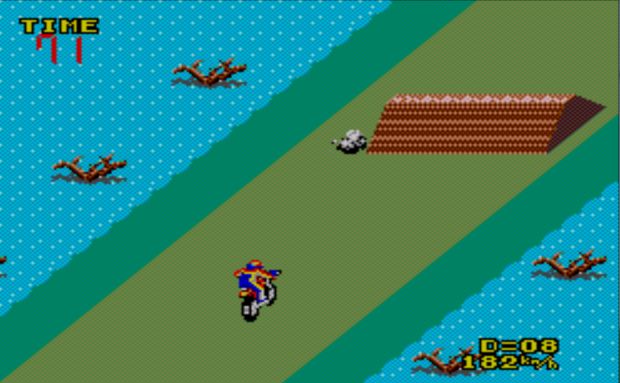Enduro Racer Has the Weirdest 80s Video Game Ending Ever
A console racer with a philosophical message at the end? It’s par for the course in the weird world of '80s videogames...
Why bother playing video games? Is it the thrill of beating a friend’s high score? Is it to enjoy the rush of besting your own fastest time? Or maybe you just play to relax, take in the scenery, and see what comes up next.
The games of arcade designer Yu Suzuki were so popular because they could be enjoyed in several different ways. You can play things like OutRun, AfterBurner, or Space Harrier competitively if you want – jostling with friends to set the fastest time or highest score – but they’re just as much fun as experiences in and of themselves. You can hurtle through Space Harrier and enjoy the sensation of speed and the array of surreal monsters that go by. OutRun provides hours of care-free racing and toe-tapping music.
Suzuki’s ’80s arcade games are largely remembered for their pseudo-3D graphics and “full body experience” cabinets, which replicated everything from an expensive Ferrari to the cockpit of a fighter jet. If you were a kid at the time, they were completely mesmerizing – that you knew, deep down, that there was no way you could ever replicate the same experience at home made them all the more enticing.
One of Suzuki’s slightly less well-remembered games was Enduro Racer, a motorcycle racing game that functioned as the off-road version of his more famous arcade hit, Hang On. For reasons best known to themselves, the home version of Enduro Racer, released for the Master System in 1987, changed the game significantly – from an into-the-screen racer to a forced-3D, isometric game more akin to Excitebike for the NES.
It could be that, in porting Enduro Racer, Sega realized that it would be cannibalizing sales from the similar-looking Hang On, which had already come out for the Master System not long before. Besides, the Master System’s humble 8-bit hardware made it more suited to a slower-paced action game with a Zaxxon-like perspective than the original game’s processor-hungry sprite scaling.

Whatever the reason, the resulting game was simple yet enjoyable: it didn’t feel like a Yu Suzuki game, but then again, none of the 8-bit ports of his games quite captured the pounding music and lurching movements of the arcade machines. In their place, you had sweet jumps, hazards to avoid, engine upgrades, and a surprisingly small selection of tracks – five in total, in fact. And then the ending kicks in.
To this day, we’re not quite sure why Enduro Racer on the Sega Master System ends with what reads like a Japanese poem about the meaning of existence. Most of the time in ’80s games, a lengthy play session concluded with a static screen and a word or two – something like “Conglaturation!” or “A winner is you!”
Instead, Enduro Racer, after congratulating you for completing all the stages, goes off on its philosophical ramble.
Here’s that text in full:
“Enduro” is a symbolic journey through life via the media of a race.
The results are insignificant and what really counts is competing.
Of particular importance are the lessons to be learned concerning one’s self from the various encounters you experience along the way.
There is no victor or loser in this test of endurance.
The only thing that really matters is that you make a commitment to begin the long and trying trek.
This game is then dedicated to all of the “life riders” who have started out on the solitary trip to find their own individual limits.
Last, but not least, may we sincerely congratulate you on a perfect run.
Exactly who wrote Enduro Racer’s Master System ending appears to be lost to history. All we know is that it’s unique to Sega’s 8-bit console. The arcade version doesn’t have it, and as this website reveals, the Commodore 64 version ends with a half-hearted, “Goal in!”
Still, it’s an ending that certainly sticks in the mind, and to this day, we occasionally think about it and wonder how on earth it ended up there.
But, you know what, Enduro Racer? You’re right. Making the commitment to the long and trying trek is all that matters. We’re going to become proper life riders and take up running again. We’re going to take the solitary trip and find our own individual limits. Right after we’ve spent a couple more hours sitting on the sofa, playing Sega games and drinking beer.